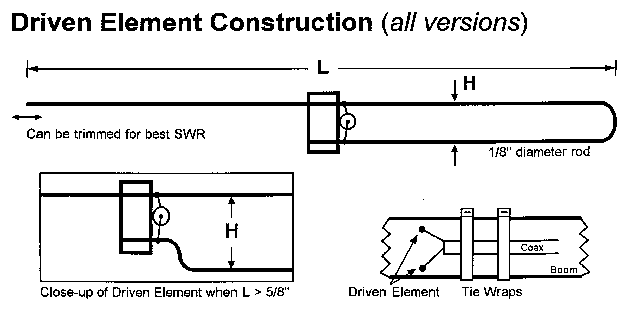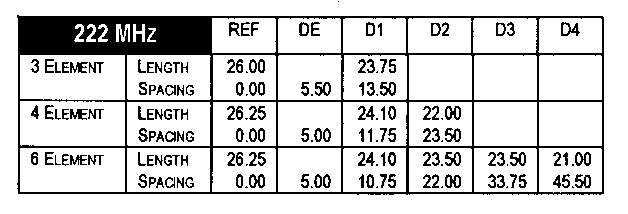
Technical Information
[SYSOP's
notes : The antennae described in this article originate from the United States
of
America where the imperial system of measurement rules. Please note that all
dimensions
in this article are in inches ! To convert to metric multiply all dimensions
in inches by 25.4 ]
The article appeared originally in the October 1996 issue of CQ VHF magazine
in the Antennas etc column. ]
[Editors notes: The antennas described in this article were built as the result of several discussions between Kent and a Cuban radio operator. While there are plenty of high performance antenna designs, most of the parts required to build them are not available in Cuba. There just isn't an EPO or Radio Shack available in Cuba. Kent accepted this as a challenge to design a really good antenna that could be built with little more than ground wire, coax and a wooden boom. Using the latest antenna design software, he has developed several variations for 144 thru 1296 MHz. Apparently, the designs work very well... Kent entered the 432 MHz version in a recent antenna contest and lost by 0.2 dB to a Midwest ham who had copied his design. Though disappointed in losing, it did prove to Kent that the antennas can be easily replicated with consistant performance.]
If you are planning to build an EME array, don't use these antennas. But, if you want to put together a Rover station with less than $500 in the antennas or just want a good antenna for the home, read on.
These antennas are relatively small, easily constructed from common materials/tools and have surprising performance. The feed method is greatly simpified by directly soldering the coax to the driven element. No baluns or gamma matches are used in this design. This simplified feed uses the structure of the antenna itself for impedance matching. The spacing of the director and reflector elements from the driven element directly affects the feed point impedance of the antenna. So, the design starts with the feed (driven element) and the elements are built around it. Typically, a high gain antenna is designed in the computer, then you try to come up with a matching arrangement for a 31.9 Ohm feed! For the cost about 0.5 dB of gain, these antennas make some design compromises for the feed impedance, use an asymmetrical feed and make trade offs for a very clean pattern. But, they allow simple measurements, have wide bandwidth, the ability to grow with the same element spacing AND... you can build these antennas for $10!!!!
The booms used for these antennas is 1/2" X 3/4" wood. The elements have been made from silicon bronze welding rod, aluminum rod, hobby tubing and solid ground wire with no change in performance. Since you want to be able to solder to the driven element, silicon bronze welding rod, hobby tubing and #10 or #12 solid copper wire have been used and work fine. A drop of "Super Glue", epoxy or RTV is used to hold the elements in place. A good coat of Polyurethane should be applied to the wooden boom to protect it from the weather. A polyurethane varnished 902 MHz version has been in the air for a while now with little deterioration in performance.
And now for the antenna designs. These antennas have been carefully designed to have the highest dB's/Dollar ratio of anything around. They were designed with YagiMax, tweaked using NEC and the driven elements experimentally determined on the antenna range. The driven element design is the same for all frequencies except for the length (L) and separation (H). See Figure 1 for details on the driven element. All dimensions are in inches.

144 MHz. This
antenna is peaked for 144.2 MHz but performance is still good at
146.52 (emergency use only!) Driven element dimensions are L = 38.5" and
H = 1.0"
Elements are 3/16" diameter. If using 1/8'' diameter material, make the
elements
0.25'' longer to compensate.
To scale this design for the FM portion of the 2m band, simply shorten each
element by 0.5''.

222 MHz. This antenna
is peaked for 222.1 MHz but performance bearly changes at 223.5 MHz.
Driven
element dimensions are L = 24.5" and H = 1.0" Elements are 3/16" diameter.

432 MHz.
This antenna is peaked for 432.1 MHz.
At this frequency, this antenna is getting very practical and easy to build.
Driven element dimensions are L = 13.0" and H = 3/8" Elements
are 1/8" diameter.

902/903 MHz. This was
the first antenna I built using the antenna to control the driven element
impedance.
The 2 1/2' length has proven practical, so I haven't built any
other versions.
Driven element dimensions are L = 5.7" and H = 1/2" Elements
are 1/8" diameter.

1296 MHz. This antenna
is the veteran of several "Grid Peditions" but I have yet to actually measure
the gain.
Dimensions must be followed with great care.
The driven element
is small enough to allow 0.141 semi-rigid coax to be used instead of RG-58.
Silicon Bronze welding rod was used for the elements but any material can
be used.
Driven element dimensions are L = 4.0" and H = 1/2" Elements are
1/8" diameter.

421.25 MHz ATV. 421
MHz Vestigial Sideband video is popular in North Texas for receiving the FM
video repeaters.
The driven element for these antennas is designed for an
impedance of 75 ohms.
So RG-59, or an `F' adapter to RG-6, can be directly
connected to a cable TV converter/Cable Ready TV on channel 57.
Driven element
dimensions are L = 13.0" and H = 1/2" Elements are 1/8" diameter. Spacing
is the same for all versions.

450 MHz FM. Yes, I
understand it's FM, but sometimes a newcomer needs a cheap antenna to get
into
a repeater or give you a simplex QSO during a contest. Driven element
dimensions are
L = 12.0" and H = 3/8" Elements are 1/8" diameter. Spacing is the same for
all versions.

435 MHz AMSAT. The
larger versions have not been fully tested and I appreciate the help and motivation
from KA9LNV for these antennas.
Updates and performance evaluations are planned
for a later edition of the AMSAT Journal.
A high Front-to-Back ratio was
the major design consideration for all versions.
The computer predicts 30
dB F/B for the 6 element and over 40 dB for the others.
NEC predicts 11.2,
12.6, 13.5 and 13.8 dBi for the 6, 8, 10 and 11 element respectively.
Using
3/4" square wood makes it easy to build two antennas on the same boom for
cross- polarized operation.
Offset the two antennas 6 1/2" and feed in phase
for Circular Polarization.
Or, just build one antenna for portable operation.
Driven element dimensions are L = 13.0" and H = 1/2" Elements are 1/8" diameter.
Spacing is the same for all versions.


theTARCinc website and this page was orginally hosted courtesy of http://vk4tub.org
(Thanks Tubby !)
Send comments to theTARCinc WebMaster at qrmvk4wit@wia.org.au
(make sure to remove the anti-spam qrm first)
Page rendering Gavin Reibelt VK4ZZ ogSOFT Software Support.
hand crafted using XT-Gold 3.0 1word Text Editor
Free DHTML scripts provided by Dynamic Drive
Last updated 8th January 2005This page is now hosted courtesy of VK4ZZ.NO-IP.ORG on a computer in Vincent, a suburb of Townsville Australia.
Contents of this page can be used freely for non-pecuniary purposes - making sure you acknowledge the great work done by Kent Britain WA5VJB !